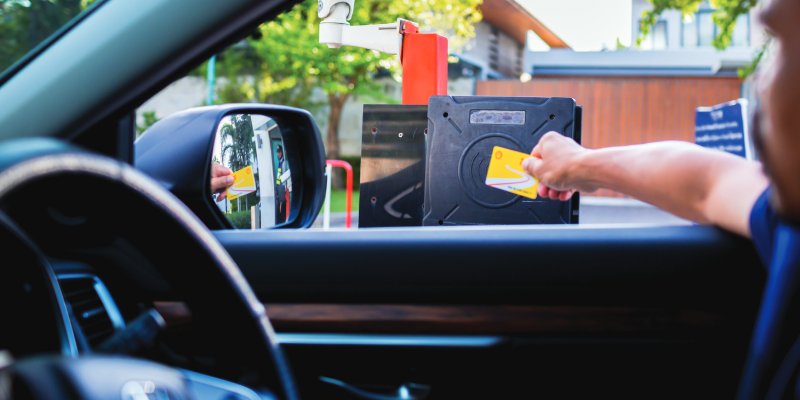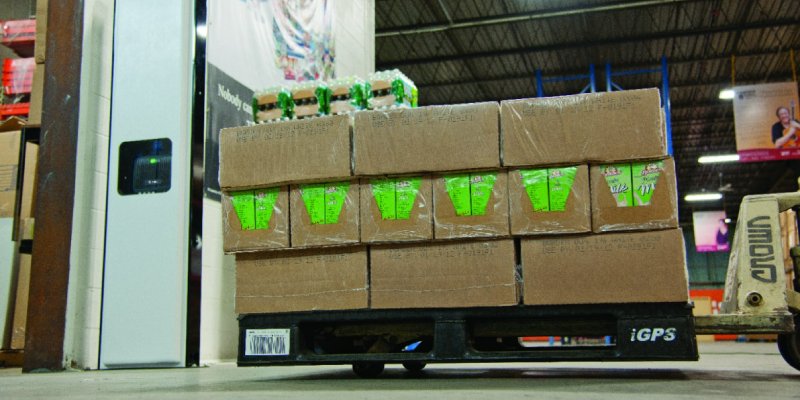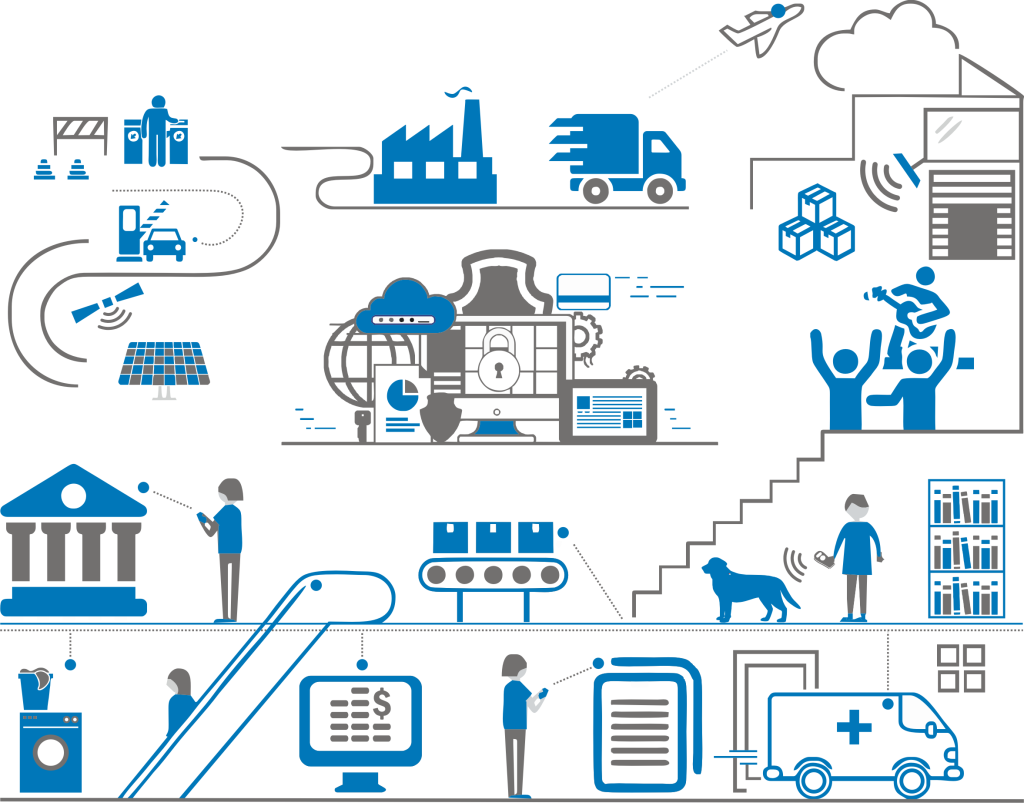RFID, in the form of FASTag, has entered the imagination of every single vehicle owner in the country. However, the application of this technology is growing across sectors. TrafficInfraTech explores the role RFID will play in the future.

The global RFID market was estimated at USD 10.7 billion in 2021, with a projection of reaching USD 17.4 billion by 2026. This showcases the potential that many envision for a piece of technology that has been around since the second world war!.
Radio Frequency Identifier is a wireless communication technology that uses the radio frequency on the electromagnetic spectrum. It largely consists of two parts – Tags and Reader. The reader emits radio waves which can trigger signals back from the tag. This data is routed back to systems that can analyse and make decisions.
RFID tags can either carry one identification number or various fields of data, depending on the requirement. If the tag is battery operated or has a power source, it is considered as an Active tag. Passive tags are those which require the reader to induce a current and a response. Active tags usually have a longer read-range than passive or semi-passive tags, and are used in sectors that require this feature.
RFIDs are deployed in industries such as automotive, logistics, transportation, retail, asset management, mining, manufacturing livestock etc.
How does RFID fit into Indian transport?
The reason why RFID has become a common term is because of its use-case in toll collection using FASTag. RFID technology is used to accurately identify a vehicle and deduct the required amount for toll collection. The entire structure of RFID is based around traceability and identification. Using RFID for toll collection is being implemented in various countries, especially across South-East Asia. In Europe, it is given out with every licence plate by the motor vehicle departments.
Beyond that however, RFID is being deployed for parking management systems, for entry-exit from commercial and residential premises, and for logistics management for better user experience. This can have a marked effect on congestion, thereby reducing fuel and time wastage. FASTag itself is being utilised for automatic collection of parking charges.
 Says, Tirthankar Kshetrimayum, Technical lead, RFID/AIDC South Asia, Middle East & Sub Saharan Africa at Avery Dennision- “Tolling is just one part of the thing. Parking systems in many countries are managed by RFID systems. There is a parking spot in Delhi which uses FASTags as the trigger point to make you understand how many parking spots are left in the area. They’re using FASTag as a data collection point for them to enable users in malls.”
Says, Tirthankar Kshetrimayum, Technical lead, RFID/AIDC South Asia, Middle East & Sub Saharan Africa at Avery Dennision- “Tolling is just one part of the thing. Parking systems in many countries are managed by RFID systems. There is a parking spot in Delhi which uses FASTags as the trigger point to make you understand how many parking spots are left in the area. They’re using FASTag as a data collection point for them to enable users in malls.”
There is potential for modern unmanned and autonomous patrol systems leveraging RFID technology to observe and identify over-speeding traffic, generate online Challans, and track passing violations. These systems work in conjunction with city traffic systems to strengthen traffic regulations and security.
 Saurav Khemani, Director, ID Tech Solutions says, “Vehicular movement on the roads can be tracked and better solutions for urban mobility can be planned, depending on the congestion. Electronic and automated traffic control systems also leverage RFID tags and IoT sensors, along with a dynamic and permanent database of information about traffic.
Saurav Khemani, Director, ID Tech Solutions says, “Vehicular movement on the roads can be tracked and better solutions for urban mobility can be planned, depending on the congestion. Electronic and automated traffic control systems also leverage RFID tags and IoT sensors, along with a dynamic and permanent database of information about traffic.
“Modern unmanned/autonomous patrol systems leverage RFID technology to observe and identify over-speeding traffic, generating online Challans, passing violations, etc. These systems work in conjunction with city traffic systems to strengthen traffic regulation and security. Parking management using RFID also reduces congestion thereby saving fuel and time.”
“Our experience of implementation of RFID system for Tolling, Parking and others, conforms the upward progression in user experience and effective management.“
 According to Ajay Rao, Head, RFID, Zebra Technologies India Pvt Ltd, “RFID solutions are truly the way forward especially with the anticipated growth of IoT and cloud computing in the toll and traffic management space. To optimise RFID systems for traffic management, it must provide sensitivity for reading weak tags, reader hardware for multi-lane deployment and dense reader operation, intelligent algorithms for cross reads and adjacent reader interference, and support for end-to-end secure data interface protocols.”
According to Ajay Rao, Head, RFID, Zebra Technologies India Pvt Ltd, “RFID solutions are truly the way forward especially with the anticipated growth of IoT and cloud computing in the toll and traffic management space. To optimise RFID systems for traffic management, it must provide sensitivity for reading weak tags, reader hardware for multi-lane deployment and dense reader operation, intelligent algorithms for cross reads and adjacent reader interference, and support for end-to-end secure data interface protocols.”
What are the issues and challenges when it comes to RFID?
With the widespread adoption of RFID, especially in the transport sector, there come various concerns with the technology and implementation. Delays and stoppages at the toll booths are just a simple example of the issues with deployment of RFID. The regulations and standards in India vary across states and regions, which can lead to discrepancies in the hardware that has been used.
Adds Trithankar,“If you’re able to come up with a draft for a standardised product implementation, it makes everything uniform. Problem is that in the South, you have a different set of hardware and tags which are being used, and North, you have another set of hardware and tags. So there is no uniformity between these as some toll plazas come under the state, some under NHAI. There is no level playing field.”
Low cost hardware, failure of FASTags, and different protocols can become stumbling blocks in the smooth operation of the RFID system in the transport sector. Read range and sensitivity are expected to keep improving, but uniform adoption and implementation can pose a challenge in India.
“Like any other security device and mechanism, RFID is not flawless. RFID poses security threats and challenges that
need to be addressed properly before deployment.” says Saurav. These include:
- Eavesdropping where unauthorised persons can read the data being transmitted between reader and tag.
- Reverse engineering of components and replicating operations.
- Counterfeiting of tags.
- RFID sniffing, where tags cannot differentiate between a valid reader and a fake reader.
This is a legitimate issue as we look at larger adoption of RFID systems with every vehicle, which makes it a possibility to monitor and manipulate the system. However, there are opposing arguments based on the technology being used.
Ajay adds, “ There has been a lot of discussion around the security and privacy threats across various forums. However, perceptions of these privacy problems vary, depending on personal tolerance and the purpose of a particular tag’s use. A well implemented system needs to consider both technological and social countermeasures because both must be implemented in a mutually beneficial manner.”
In most standard system design, RFID tags do not contain any personally identifiable information about consumers. The only information that is contained in the EPC/RFID tag relates to the product, and not the purchaser. This makes it impossible to just use the information from the RFID tag to track the entity, without the overall system making sense of the tag’s data.
“There are sufficient checks kept to ensure that misuse of any such data can be kept to minimum. This is generally accomplished by ensuring end to end security of the RFID system as elucidated in the RFID data security. Once the data is secured throughout the pipe, an eavesdropper will not be able to make sense of the data as it will be encrypted and can only be decrypted by the entity with the right key. This is very similar to the standard encryption mechanisms that help secure the financial transactions over the internet.”
Solutions
There is consensus amongst RFID manufacturers that the solutions exist but require more deployment. Packaging features can protect the identity of the object being tagged and encryption can bolster the security. You have tamper-proof and tamper-evidence tags which can be used, along with shielding for physical protection. Saurav says, “We can use encryption algorithms to secure the data from getting into the wrong hands.
Robust encryption and hashing techniques can secure users’ data, such as vehicle number, name, vehicle registration details, vehicle location, etc. Also, if someone tries to exploit or attack the RFID technology, enterprises can integrate a machine learning-based smart detection system that can trigger a kill code. It will make the RFID unresponsive permanently.”
“Block chain technologies can be used for multi-level authentication and authorization for making sense of illegally acquired RFID data. A consortium is required for implementation of the paradigm that also includes patent protection”
Generally, an implemented system needs to consider both technological and social countermeasures as both must be implemented in a mutually beneficial manner. There should be sufficient checks made of the tags and the overall system to ensure that misuse of any such data can be kept to minimum. This is generally accomplished by ensuring end to end security of the RFID system.
A part that is often overlooked is the data integrity within the RFID reader and the data transmission to the application from the RFID reader.
Ajay states, “The data transfer between the tag to reader is governed by ISO18000-6c protocol designed on Gen2V2 RFID specification which has security as a building block for over-the-air communication between the tag and the reader. Using the right solution standards will ensure that the data transfer is not tampered with during this transfer. “The RFID devices can provide secured data access over the network on multiple application layer and transport layer protocols. But defining these parameters during the system design is extremely critical to maintain a proper hygiene of the complete RFID system. Readers can proactively guard against security threats and vulnerabilities by integrating multiple layers of protection.
This is achieved by providing a choice of multiple configurable security layers and protocol interfaces needed to comply with industry leading standards for secure transactions.”
Other use-cases for RFIDs
Although RFID has come to the forefront due to FASTag and transportation-based solutions, the larger use-case for this technology lies in other industries.
 Ashim Patil, MD, Infotek Software states “Retail is one of the biggest areas for RFID adoption in recent years, especially in apparel, footwear, jewellery, art and décor. The solution for inventory management, omni-channel fulfilment, faster point of sales, fitting room analytics, smart mirrors – For all these RFID is an enabler, playing an instrumental role. If you look at retail RFID adoption in the USA, it’s close to 74%. And India is gearing up very fast. All the major retailers are in the pilot stage or in the regional roll out stage. We see a big surge and growth in the technology penetration in these areas.”
Ashim Patil, MD, Infotek Software states “Retail is one of the biggest areas for RFID adoption in recent years, especially in apparel, footwear, jewellery, art and décor. The solution for inventory management, omni-channel fulfilment, faster point of sales, fitting room analytics, smart mirrors – For all these RFID is an enabler, playing an instrumental role. If you look at retail RFID adoption in the USA, it’s close to 74%. And India is gearing up very fast. All the major retailers are in the pilot stage or in the regional roll out stage. We see a big surge and growth in the technology penetration in these areas.”
RFID in the retail industry encompasses various requirements, being deployed for inventory management, materials management, packaging, and logistics. But beyond that, RFID is also used for consumer engagement and counterfeit protection.
Consumer engagement makes use of NFC enabled phones to connect with consumers and process their information, including payment. For counterfeit protection, RFID tags are embedded in luxury brand products, like bags, belts, shoes. Reading these tags with your phone can give you the manufacturing date, the factory it was manufactured in, and the batch of leather it came from. This provides product authentication and brand protection.
Logistics is another important sector for RFID, with ports implementing gate automation at various terminals. This can significantly reduce throughput time for gate-in and gate-out at the terminal, along with vehicle identification and verification. Indian Customs has also deployed RFID tags on export containers, thereby giving them accurate data on movement.
Automotive manufacturing uses RFID for production tracking, even in high-temperature and high-corrosive processes like the paint shop. The Defence sector uses tags for identification and tracking of critical assets. They are even being mandated for passports across the world, creating a method to verify and track. The scope and potential for RFID is large and it’s growing further every year.

Cloud computing and Internet of Things (IoT)
RFID systems are based around readers and tags, which need to be connected to a network. This opens up potential for a shift to cloud-based computing, which will be spurred on by evolving technology and higher penetration of stable 5G connections. It becomes especially relevant for the nascent FASTag market.
Says Saurav, “With the help of IoT, RFID systems can track different systems keeping a note of other attributes such as weight, temperature, etc. Tracking objects and items uniquely in industries leverages RFID that embeds the Industrial Internet of Things.
“Now, all these dynamically expanding sets of information generated by RFIDs in conjunction with IoT devices and sensors require enormous computation and storage for effective management of such unique details. That is where RFID technology leverages cloud computing power to maximize its utilization without any limitation.
“Needless to say, information on managed cloud and with help of common analytics, can broadcast precautionary messages to social fabrics for in-time intervention to avoid disaster to whole eco system. We need a regulatory framework for Information Exchange- M2M, M2C and Data Architecture and Storage.”
Ajay asserts that we are witnessing the move of almost all major applications to Cloud based systems. The main proponent is to have centrally manageable and scalable infra. With decisions shifting to more informed data based analytics, the need for IoT based sensors is increasing rapidly for collection of data at the physical end points. RFID adds into the system as a critical IoT component providing the key data in real time.

“Adopting a common IoT-based architecture would greatly reduce human dependency and provide easy data exchange, monitoring and management of these edge devices via a centralised cloud-based scalable infrastructure. This will allow more standardisation in tech implementation which will then lead to a better controlled and managed system while reducing the total cost of ownership (TCO)”
When combined with cloud computing, RFID can unlock a host of possibilities for IoT centering around data analysis. RFID can integrate with other sensors to provide a seamless integrated IoT. For example, if you bought something at the store, the RFID alerts the store of what products are moving. This can provide data on consumer demand and shelf inventory, which helps store optimisation.
Integrating IoT with cloud computing can lead to real-time data capture and processing. Research is also being conducted on chipless RFID tags that can potentially reduce costs and increase adoption. Combining data collection technology like RFID systems with Artificial intelligence and Machine learning, can further provide businesses with necessary insights and intelligence to help make swift decisions that translate to greater efficiency and profitability across the value chain.
Listing the key considerations while choosing RFID devices Ajay points out the devices should be able to handle and control data at the edge without consuming additional resources. They should connect directly to the cloud infrastructure and share data without any additional computing or storage devices needed at the edge infrastructure. Apart from offering a high level of data security when data is being sent to the host system, the devices should have the capability to adapt and communicate on widely used IoT protocols.
 TrafficInfraTech Magazine Linking People Places & Progress
TrafficInfraTech Magazine Linking People Places & Progress
